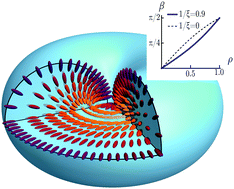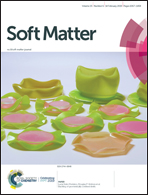Curved boundaries and chiral instabilities – two sources of twist in homeotropic nematic tori†
Abstract
Many liquid crystalline systems display spontaneous breaking of achiral symmetry, as achiral molecules aggregate into large chiral domains. In confined cylinders with homeotropic boundary conditions, chromonic liquid crystals – which have a twist elastic modulus which is at least an order of magnitude less than their splay and bend counter parts – adopt a twisted escaped radial texture (TER) to minimize their free energy, whilst 5CB – which has all three elastic constants roughly comparable – does not. In a recent series of experiments, we have shown that 5CB confined to tori and bent cylindrical capillaries with homeotropic boundary conditions also adopts a TER structure resulting from the curved nature of the confining boundaries [P. W. Ellis et al., Phys. Rev. Lett., 2018, 247803]. We shall call this microscopic twist, as the twisted director organization not only depends on the confinement geometry but also on the values of elastic moduli. Additionally, we demonstrate theoretically that the curved geometry of the boundary induces a twist in the escaped radial (ER) texture. Moving the escaped core of the structure towards the center of the torus not only lowers the splay and bend energies, but lowers the energetic cost of this distinct source for twist that we shall call geometric twist. As the torus becomes more curved, the ideal location for the escaped core approaches the inner radius of the torus.

- This article is part of the themed collection: Soft Matter Emerging Investigators


 Please wait while we load your content...
Please wait while we load your content...